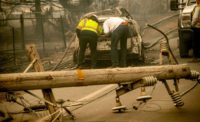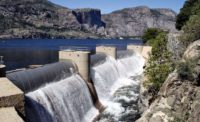A federal bankruptcy judge has ruled that a jury should determine whether Pacific Gas & Electric Corp. is responsible for the Tubbs fire of 2017, one of California’s worst wildfires, which could account for as much as two-thirds of the wildfire claims for 2017 and 2018.
The ruling comes nearly seven months after The California Dept. of Forestry and Fire Prevention absolved the utility of guilt, finding the fire was caused by a private electrical system adjacent to a residential structure. Victims and creditors disagree with the agency’s conclusion.
The Tubbs Fire in Sonoma County started Oct. 8, 2017, and burned 36,807 acres, destroyed 5,636 structures and caused 23 deaths.
PG&E Corp. voluntarily filed for Chapter 11 bankruptcy protection in January 2019 after the 2018 Camp fire, the state’s deadliest with 85 casualties. PG&E faces more than $30 billion in liabilities from the 2017 and 2018 fires. A number of contractors and suppliers have claims against the utility. Turner Construction is owed $20 million, Quanta Electric Services is owed $16 million, and Roebblen Contracting is owed $38 million.
Federal Judge Dennis Montali of the U.S. Bankruptcy Court in San Francisco also ruled that two groups of creditors could not propose Chapter 11 exit plans for the utility, saying claims would be resolved quicker with PG&E in charge of the process. The company plans to file its exit plan by Sept. 9, which would have it emerge from bankruptcy next June, Paul Doherty, a PG&E spokesman, told ENR.
Judge Montali’s decision to allow claims to go to a jury trial in California Superior court does not interfere with the company’s goal to file a reorganization plan, Doherty says. The plan “will compensate victims fairly and support California’s energy future,” he says.
But the decision to let the claims go to trial is perceived to be negative, says Paul Patterson, an analyst with Glenrock Associates. “The company didn’t want it. “PG&E is a volatile name, and there is a lot of uncertainty about the outcome,” he adds.
PG&E Corp.’s CEO Bill Johnson is seeking help from legislators in Sacramento, says Patterson. Under a legislative proposal meant to protect ratepayers and place the entire economic burden of the 2017 and 2018 fires on PG&E shareholders, the company would be allowed to sell tax-free wildfire recovery bonds. The bonds would ensure that the company continues to honor existing labor agreements and clean energy commitments, the proposed legislation says. It also would allow the company to borrow money to contract for engineering and architectural services and pay reasonable costs of consulting engineers and construction of projects approved by the court. The bonds would hold PG&E accountable to wildfire victims and would be repaid with company profits, the company says.
Two hedge funds that are PG&E shareholders, Knighthead Capital Management and Abrams Capital Management, have proposed to raise $15 billion to fund PG&E’s bankruptcy exit plan by purchasing shares of new common stock.
To qualify to participate in a $21-billion wildfire insurance fund established by the legislature, PG&E must emerge from bankruptcy by June 2020, which it would do, according to a draft plan.
The fund was established July 11, when Gov. Gavin Newsom signed the “urgency” bill into law. The state’s three largest utilities—Southern California Edison, San Diego Gas & Electric and PG&E (once it emerges from bankruptcy)—can tap into the fund only if they each agree to make $5 billion in safety improvements to their electric girds. They also must pass annual safety certifications and limit executive pay.
Half the fund is supported by a monthly charge to ratepayers and the other half by utilities, with PG&E contributing the largest share.
PG&E Corp. on August 13 appointed Andrew Vesey as president and CEO of its subsidiary utility, PG&E Co.




